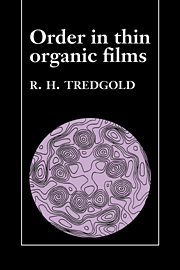Book contents
7 - Liquid crystals
Published online by Cambridge University Press: 21 September 2009
Summary
Introduction
As was pointed out in Chapter 1 liquid crystals (or mesophases as they are often called) were first discovered by Reinitzer in 1888 and the first proper classification of liquid crystals was made by Friedel in 1922. Since that time various new categories of liquid crystals have been discovered and named. It would be impossible to give an extensive treatment of this important and wide ranging subject here but, as so many of the systems discussed in this book have a liquid crystalline structure, at least a brief treatment of the topic is essential. Furthermore, several methods of forming ordered thin organic films not treated in other chapters depend on the initial formation of a mesophase. It has been suggested that something like 10% of fine organic materials listed in a typical catalogue of such products are capable of existing in a mesophase within some appropriate temperature range or, in the case of lyotropic liquid crystals, when dissolved at an appropriate concentration in some solvent. It is thus obvious that the subject has immense ramifications and could not be pursued in any great breadth here.
Liquid crystals can initially be divided into thermotropic and lyotropic materials. The first category involves a single molecular species and exists in a temperature range which lies between the melting point of the solid phase and the temperature at which a true liquid is arrived at.
- Type
- Chapter
- Information
- Order in Thin Organic Films , pp. 135 - 150Publisher: Cambridge University PressPrint publication year: 1994



